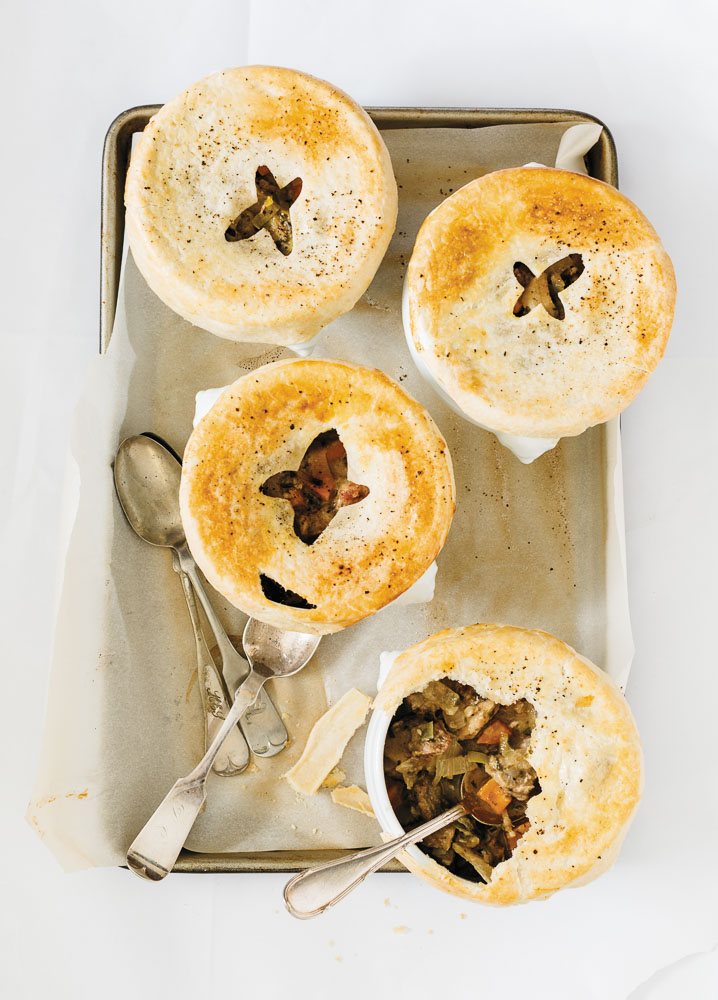Pork, Prune & Apple Pot Pies
Photo by Michael Piazza / Styled by Catrine Kelty
This recipe, based on a stew from the excellent The Slow Mediterranean Kitchen by Paula Wolfert, is essentially braised pork and apples in sauce with a pastry lid, just like a chicken potpie. Wolfert based her recipe on one from southwest France, but to me it’s always felt more Anglo Saxon, seasoned with warming, wintery spices, dried fruit and mustard. Treating the slightly-sweet stew as a pie feels like a very medieval-England thing to do, like real mincemeat, or a picnic pork pie served with chutney. The addition of fresh apple to the filling creates a lovely, thick sauce, stretching a small amount of meat to feed more people. The instructions below are for individual potpies made in footed onion soup crocks; feel free to use fluted ramekins, small bowls or even a deep pie dish to serve family-style.
The stew itself is worth making even if you don’t plan to potpie it; make it ahead of time so the flavors really develop, then thin it out a bit with some broth or water and mash the pork cubes slightly. Served hot over fresh egg noodles with lemon-parsley gremolata and some Parmigiano Reggiano, you can stretch this recipe to feed at least 8 people.
Serves 4–8
1½–2 pounds pork shoulder, cut into 1-inch cubes
Kosher or sea salt
Freshly ground black pepper
¼ teaspoon cinnamon
Pinch freshly ground nutmeg
2 tablespoons all-purpose flour
Extra virgin olive oil
1 cup white wine
1 small onion, sliced (about 1½ cups)
1 leek, split lengthwise and sliced into ¼” slices
4 cloves garlic, minced
2 carrots, peeled and diced
1 large apple, diced (about 2 cups)
2 tablespoons Dijon mustard
1 cup chicken stock or water
1 bay leaf
1 tablespoon fresh thyme leaves
2 tablespoons red wine vinegar
1 cup flat leaf parsley leaves, chopped
6 prunes, quartered
½ recipe pâte brisée, chilled, or good store-bought pie crust
1 egg, beaten
Coarse salt and pepper
Toss the cubed pork with 1 teaspoon salt, the cinnamon and nutmeg and the flour. Shake to fully coat each piece of meat. Heat 2 tablespoons olive oil in a heavy Dutch oven and add the pork in an even layer (you can brown the meat in batches if necessary.) Cook until well-browned on all sides. Use a slotted spoon to transfer to a plate and repeat with remaining pork.
A deep brown crust will form at the bottom of the pot; deglaze it with the white wine, scraping all the brown bits from the bottom and incorporating them into the wine. Bring to a boil and reduce the liquid until almost a glaze, then add the onions, leek, garlic, carrot and apple. Toss to coat in the winey glaze, season with salt and pepper to taste, then add the mustard, stock or water, bay leaf, thyme and 1 tablespoon of the vinegar. Stir to combine, bring to a simmer, cover, and reduce the heat to low. Cook 45 minutes to an hour, or until the pork is tender, then stir in the remaining vinegar, the parsley and the prunes; taste for seasoning and add more salt if needed. You can prepare the stew up to this point and chill it, making the potpies the following day; just be sure to reheat the stew gently before proceeding, adding a little water to thin it out if needed.
Preheat the oven to 400°F.
When the stew is cooked, ladle individual servings into four footed soup crocks or potpie ramekins. Allow the stew to cool in their vessels a little bit while you prepare the pastry lids.
Roll out the dough to ¼” thick on a floured board and using an extra crock or ramekin as a guide, cut into four circles to fit over the stew with about ½–¾-inch overhang. Cut an “x” in the middle of each circle, and using a pastry brush (or your finger), rub the edges of the pastry with the beaten egg. Invert over the top of each crock and adhere the pastry to the outside by pressing firmly, then brush the top and sides with more egg wash. Sprinkle with coarse salt and pepper and place on a sheet tray. Bake in the hot oven 15 minutes or until the pastry is golden and cooked through, and the stew is beginning to bubble through the “x.” Serve immediately, with more Dijon mustard on the side, if you wish.
This recipe appeared in the Winter 2016 issue as part of a larger story on Savory Pies.

